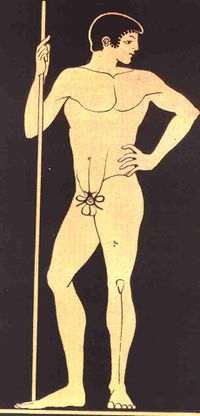Difference between revisions of "Kynodesme"
WikiModEn2 (talk | contribs) |
m (add interlanguage link) |
||
| Line 31: | Line 31: | ||
[[Category:From Intactipedia]] | [[Category:From Intactipedia]] | ||
[[Category:From IntactWiki]] | [[Category:From IntactWiki]] | ||
| + | |||
| + | [[de:Kynodesme]] | ||
Revision as of 01:53, 30 December 2019
In ancient Greece, the kynodesme (κυνοδεσμη, lit. "dog leash") was a thin leather strap that was wound around the acroposthion (AKA the part of the foreskin which hangs past the head of the penis), which pulled the penis upward and was tied in a bow, tied around the waist, or secured by some other means.[1] Vase paintings and statues frequently portray nude athletes and komasts wearing the kynodesme.
Public exposure of the glans was considered unsightly and indecent, as an exposed glans was associated with intimate circumstance of having an erection.[1] Furthermore, an exposed glans resembled the permanently externalized glans of the circumcised penis, where the removal of the foreskin was considered akin to castration.[1]
The Greeks used term psolos (ψωλος, lit. "having an erection") to describe a man with an exposed glans.[1] The term was not exclusive to a man who was circumcised, but could apply to any man with an exposed glans, either actually having an erection, or a man who was afflicted with lipodermos.[2]
The kynodesme, then, was used in ancient Greek society as a means to prevent the public indecency of an exposed glans when nude.[1]
References
- ↑ a b c d e
 Hodges, F.M.. The Ideal Prepuce in Ancient Greece and Rome: Male Genital Aesthetics and Their Relation to Lipodermos, Circumcision, Foreskin Restoration, and the Kynodesme. Bull. Hist. Med.. September 2001; 75(3): 375-405. PMID. Retrieved 1 November 2019.
Hodges, F.M.. The Ideal Prepuce in Ancient Greece and Rome: Male Genital Aesthetics and Their Relation to Lipodermos, Circumcision, Foreskin Restoration, and the Kynodesme. Bull. Hist. Med.. September 2001; 75(3): 375-405. PMID. Retrieved 1 November 2019.
- ↑ Ada Adler, ed., Suidae Lexicon, 5 vols.(Lexicographie Graeci, vol.1) (Leipzig: Teubner, 1935), 4: 849.
